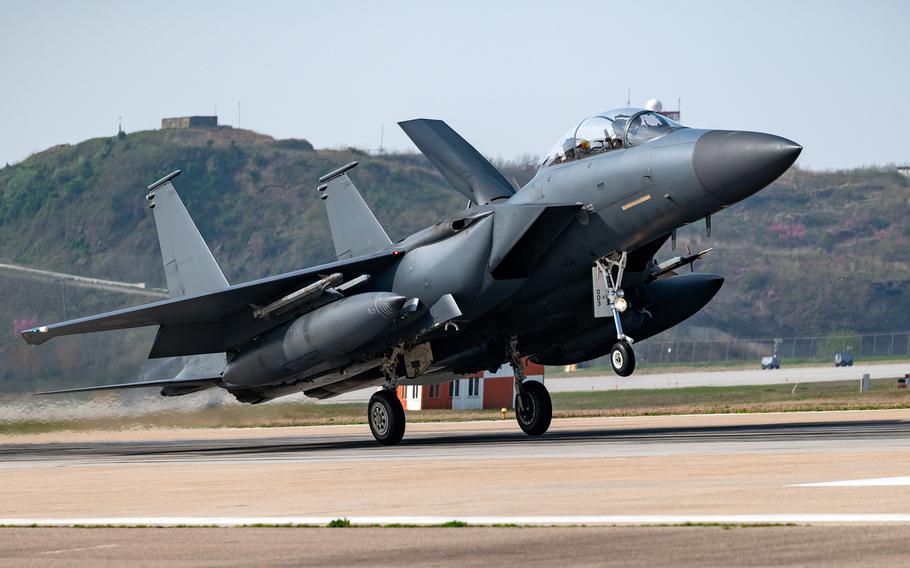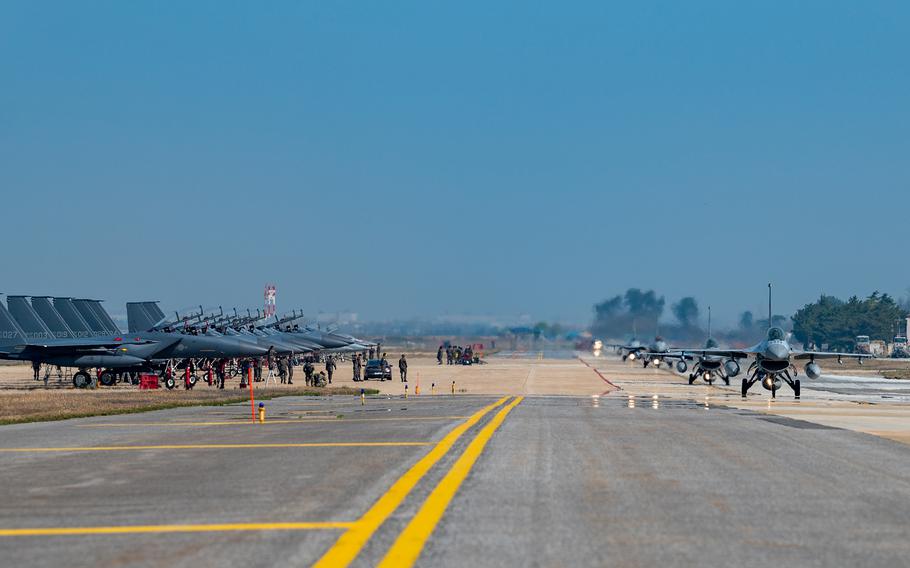
A South Korean air force F-15K Slam Eagle arrives for the Korea Flying Training exercise at Kunsan Air Base, South Korea, April 12, 2024. (Samuel Earick/U.S. Air Force)
CAMP HUMPHREYS, South Korea — The United States and South Korea are carrying out their largest, annual aerial training to “deter, defend and defeat” enemies in and around the Korean Peninsula, according to an Air Force news release.
The 7th Air Force at Kunsan Air Base, about 115 miles south of Seoul, is coordinating the 15-day exercise, dubbed Korea Flying Training, which kicked off Friday.
The release described the training as “defensive in nature” and did not mention North Korea, which regularly condemns joint military drills between the United States and the South.
President Joe Biden and South Korean President Yoon Suk Yeol agreed to “expand the scope and scale of combined military exercises” in and around the Korean Peninsula due to the North’s nuclear and missile threats, according to a joint statement on May 21, 2022.
Korea Flying Training began less than two weeks after North Korea launched an intermediate-range ballistic missile. The solid-fueled weapon, launched April 2 from the Pyongyang area, flew roughly 370 miles before splashing down in the Sea of Japan, or East Sea, according to the South’s Joint Chiefs of Staff.
The missile was equipped with a hypersonic glide vehicle capable of traveling more than 3,800 mph, the communist regime’s Korean Central News Agency reported the next day.

Aircraft from the South Korean air force arrive for the Korea Flying Training exercise at Kunsan Air Base, South Korea, April 12, 2024. (Samuel Earick/U.S. Air Force)
Korea Flying Training is focusing on integrating fifth-generation aircraft, including the F-35 Lightning II, with other U.S. and South Korean jets during the drill, the Air Force release said. Other scenarios include combat search and rescue, precision strikes, airborne operations and defending against aerial and ground-based threats.
About 25 types of aircraft from both air forces, the U.S. Army, U.S. Marine Corps and U.S. Special Operations Command are scheduled to participate in the exercise, the release said. These include the F-35B, F-16 Fighting Falcon, A-10 Thunderbolt II, MQ-9 Reaper and C-130J Super Hercules.
F-35As, F-15K Slam Eagles, C-130 Hercules and KC-330 Cygnus from South Korea are also participating, according to the release.
The 7th Air Force did not immediately respond to an email Tuesday requesting the number of aircraft used and whether munitions will be dropped while training.
Joint military training by the two allies is carried out year-round on land, air and sea in and around the peninsula.
More than 130 U.S., South Korean and Australian aircraft conducted a five-day airpower demonstration dubbed Vigilant Defense on Oct. 23, the South’s military said at the time.
Eleven months earlier, roughly 240 U.S. and South Korean aircraft flew about 1,600 sorties during another airpower exercise called Vigilant Storm.
Col. Charles Cameron, 7th Air Force’s director of operations and plans, described Korea Flying Training as “the most realistic opportunity for our forces.”
“KFT is a critical training event due to the sheer size of the exercise, the amount of aircraft and people involved from across the joint and allied forces, and the complexity of the training,” he said in the release.